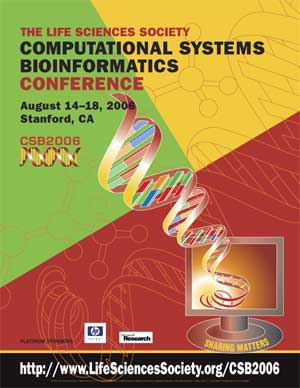A SYSTEMS BIOLOGY CASE STUDY OF OVARIAN CANCER DRUG RESISTANCE
Jake Y. Chen*, Changyu Shen, Zhong Yan, Dawn P. G. Brown, Mu Wang
Indiana University School of Informatics, IUPUI, Indianapolis, IN 46202, USA. jakechen@iupui.edu
Comput Syst Bioinformatics Conf. August, 2006. Vol. 5, p. 389-398. Full-Text PDF
*To whom correspondence should be addressed.

In ovarian cancer treatment, the chemotherapy drug cisplatin often induce drug resistance after prolonged use, causing cancer relapse and the eventual deaths of patients. Cisplatin-induced drug resistance is known to involve a complex set of cellular changes but its molecular mechanism(s) remain unclear. In this study, we designed a systems biology approach to examine global protein level and network level changes by comparing Proteomics profiles between cisplatin-resistant cell lines and cisplatin-sensitive cell lines. First, we used an experimental proteomics method based on a Label-free Liquid Chromatography / Mass Spectrometry (LC/MS) platform to obtain a list of 119 proteins that are differentially expressed in the samples. Second, we expanded these proteins into a cisplatin-resistant activated sub-network, which consists of 1230 proteins in 1111 protein interactions. An examination of network topology features reveals the activated responses in the network are closely coupled. Third, we examined sub-network proteins using Gene Ontology categories. We found significant enrichment of proton-transporting ATPase and ATP synthase complexes in addition to protein binding proteins. Fourth, we examined sub-network protein interaction function categories using 2-dimensional visualization matrixes. We found that significant cellular physiological responses arise from endogeneous, abiotic, and stress-related signals, which correlates well with known facts that internalized cisplatin cause DNA damage and induce cell stress. Fifth and finally, we developed a new visual representation structure for display of activated sub-networks using functional categories as network nodes and their crosstalk as network edges. This type of sub-network further shows that while cell communication and cell growth are generally important to tumor mechanisms, molecular regulation of cell differentiation and development caused by responses to genomic-wide stress seem to be more relevant to the acquisition of drug resistance.
[CSB2006 Conference Home Page]....[CSB2006 Online Proceedings]....[Life Sciences Society Home Page]